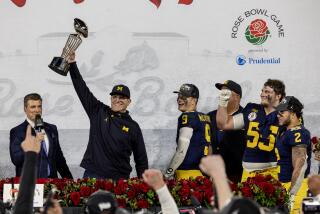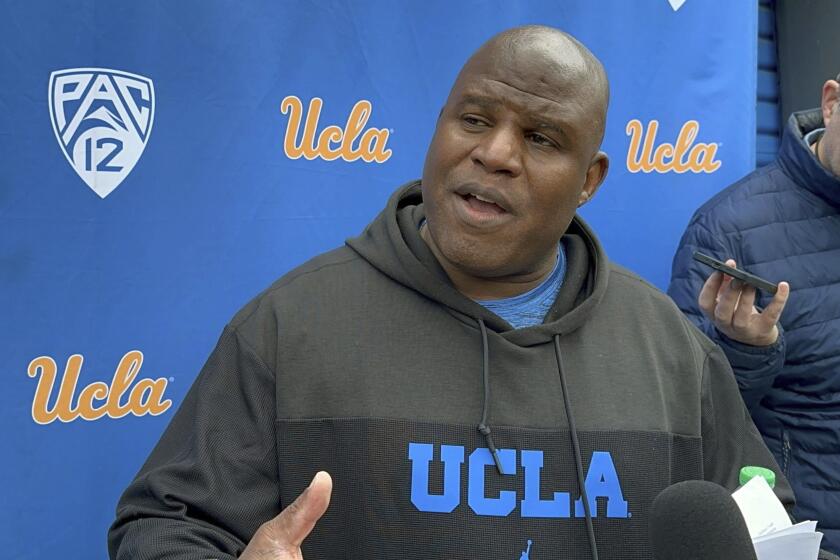COLLEGE FOOTBALL ’92 : Trying to Clean Up a Mess : Bowls: The new alliance should make back-room deals and bad games history, and maybe a true national champion will be the result.
Depending on how it all turns out, America has Tom Mickle to thank or curse for a new bowl system that makes its long-awaited, much-debated debut at season’s end.
Years in the making, more complicated than a physics lesson in Latin and, in some cases, only grudgingly accepted by a suspicious football constituency, the infant bowl alliance at last becomes a reality. Because of it, college football may never be the same.
The architect of the plan is Mickle, the Atlantic Coast Conference assistant commissioner who sat down one day in 1990 and devised a simple formula to improve the bowl selection process and with it, the ACC’s national stature in football.
Mickle’s idea involved three bowls, Cotton, Sugar and Orange; the three automatic participants in those bowls, the Southwest Conference champion to the Cotton, Southeastern champion to the Sugar and Big Eight champion to the Orange; and a remaining pool of three opponents, Notre Dame and the Big East and ACC champions.
One problem: What would happen if Notre Dame was ranked No. 1 and, say, Big East champion Miami was No. 2? Under Mickle’s initial plan, the two teams would be unable to meet in a bowl game.
From this, a monster was born. What started as a system that involved three bowls grew to seven--Cotton, Sugar, Orange, Fiesta, Blockbuster, Gator and Hancock. Instead of the original five conferences, there are now six, thanks to the addition of the Pacific 10. And because of the restructuring, coalition members are guaranteed 11 of those 14 available bowl invitations.
“In my head, it’s very clear,” Mickle said, trying to detail the new arrangement. “But I’m not great (at) explaining it to people. I’m sure I confuse other people talking to them.”
Great. Actually, the particulars of the selection process aren’t as important as the potential result. If everything goes as expected--and there’s the rub--the bowl alliance will do postseason college football a tremendous favor, cleaning up a process that reeked of back-room bargaining and often resulted in unattractive games. Seriously--No. 3 Florida vs. No. 18 Notre Dame in the 1992 Sugar Bowl?
Under the old rules, deals were made before the regular season was completed. That’s what happened to the Sugar Bowl, when it committed itself to the Irish, only to watch Notre Dame lose two of its three remaining games.
The revised Mickle system eliminates the need for such premature negotiations. It also increases the chances for the Nos. 1 and 2 teams to meet or, at the very least, it improves the matchups.
For example, had the bowl alliance been in business last season, Florida probably would have faced No. 1 Miami, not Notre Dame in the Sugar Bowl. Instead, No. 11 Nebraska played the Hurricanes in the Orange Bowl and lost, 22-0.
The new system isn’t without its detractors or its disadvantaged. The Rose, Citrus, Holiday, Silver (previously known as the California Bowl), Peach, Freedom, Liberty, Hall of Fame, Copper, Independence and Aloha Bowls have, for assorted reasons, been left out of the alliance. And what happens if an independent--such as East Carolina, which finished 11-1 last season--goes undefeated in 1992? With no ties to the consortium, East Carolina would be locked out of the major bowl picture.
The same goes for Penn State, which found itself in bowl limbo after joining the Big Ten. Unable to compete for the league championship until next season, Penn State also was frozen out in 1992.
The Nittany Lions, in an unprecedented move, have signed with the Blockbuster Bowl for this season only. The Blockbuster later joined the consortium, but as a so-called second-tier bowl, meaning it would take a medium-sized miracle for Penn State to have a chance at a national championship.
Surprisingly, Notre Dame might not have improved its position by joining the alliance. True, the Irish are more or less guaranteed no worse than a place in the Fiesta, Sugar, Cotton or Orange bowls, but with their national prominence, Notre Dame was probably a lock for one of those games anyway.
There were the usual disagreements among the coaches.
“I probably don’t have a complete understanding of the reasons, what it’s about, but my general feeling is I don’t like it,” said LaVell Edwards of Brigham Young. “They’re taking a giant step toward a playoff system, and I have not been in favor of a playoff.
“I can see in this alliance thing that most of the Western teams are going to be cut out of many (of the) bowl options,” he said.
Then there is Florida State’s Bobby Bowden, whose Seminoles, a longtime independent, begin ACC league play this season. He said he couldn’t be happier with his new league or the new consortium.
“I think we came out smelling like a rose,” he said. “I liked it from the first moment I saw it. I guess you have to be an independent all your life to get excited about it. Here, we got a choice if we win the conference.”
Nor was Bowden upset about the bowl alliance being a precursor to a playoff system.
“The way she is, it’s about as close to a college playoff as we’re going to get in my day,” he said. “I’m striving to get to (the year) 2000. I just don’t think we’re going to get a playoff.”
The winners of the new system are obvious enough. Mickle’s ACC, which was locked into the Citrus, will have its choice of the Orange, Cotton or Sugar. The Big East, in only its second year as a football league, receives the same benefit. It can thank Miami for that perk.
The Fiesta Bowl improved its stature with a consortium contract clause that says if Notre Dame, the Big East champion or the ACC champion are ranked Nos. 1 and 2 in the AP poll, they must play in the game at Tempe, Ariz. That means if Miami were No. 1 and Notre Dame No. 2 at regular season’s end, the Fiesta would get the national-championship matchup.
A final bowl winner was the Pac-10, which has agreements with three bowls. The champion goes to the Rose Bowl. The No. 2 Pac-10 team goes to the Orange, Cotton, Sugar, Fiesta, Blockbuster, Hancock or Gator. In most years, it probably will be the Fiesta. And the No. 3 Pac-10 finisher goes to the Freedom Bowl.
There is one other possible trickle-down effect of the consortium: improved schedules. The way Mickle sees it, alliance members, as well as the Big Ten--which signed a separate deal with the Citrus and Holiday--will raise the quality of their nonconference schedules. With some conferences guaranteed at least three bowls, the desire for soft schedules decreases.
“There’s not as much tension and fear out there about scheduling wins,” Mickle said. “People are much more willing to go out and play some (tough teams), rather than schedule Division I-AA or lower Division I-A games.”
The exception: the SEC, which goes to an eight-game conference rotation this year.
Whatever happens in this, the inaugural bowl alliance season, Mickle said he can live with the results. In his mind, it is a far, far better world with the alliance than without it.
“I hope that it will bring better games, more sanity to the bowl system and make people more interested in football,” he said.
And if doesn’t, not to worry. The contract can be revised every three years.
A Whole New Ballgame
A look at the new structure for postseason college bowl games.
HOW THE BOWL ALLIANCE WORKS * 1. The Orange, Sugar, Cotton and Fiesta Bowls (Tier 1) have joined with the Atlantic Coast Conference, the Big East Conference and Notre Dame in a partnership. At stake is the opportunity for Notre Dame and the champions of the ACC and the Big East to appear in one of those games each year. In addition, the ACC and the Big East champions are guaranteed a spot in the Orange, Sugar or Cotton Bowl each year.
* 2. The current commitments of the conference champions of the Big Eight to the Orange Bowl, the Southeastern to the Sugar and the Southwest to the Cotton Bowl remain intact, leaving two additional berths open in the four Tier 1 coalition bowls.
* 3. Those two berths will be filled from a pool of at-large teams that will include the next-best team (as selected by the Tier 1 coalition bowls) from the following five conferences: ACC, Big East, Big Eight, Pacific 10 (whose champion remains committed to the Rose Bowl) and Southwest.
* 4. The three at-large teams not selected to the Tier 1 bowls will then be available for selection to the Tier 2 bowls, which feature the Gator, Blockbuster and Hancock.
5. The team selection date for all the bowls involved in the coalition (Tier 1 and Tier 2) will take place after the SEC championship game Dec. 5.
HOW THE TEAMS ARE PICKED * 1. Whenever Notre Dame, the ACC and the Big East champions occupy the No. 1 and No. 2 rankings in the final regular-season Associated Press poll, they must play the national championship game in the Fiesta Bowl.
Example: Notre Dame is No. 1, Miami is No. 2. They are automatically assigned to the Fiesta Bowl.
* 2. Whenever the No. 1 or No. 2 team in the final regular-season AP poll comes from among the ACC champion, the Big East champion or Notre Dame and the host conference champion from among the Sugar, Cotton or Orange Bowl is ranked No. 1 or No. 2, these teams must play one another in the bowl of the host conference champion.
Example: Notre Dame is No. 1, Texas A&M; is No. 2. Notre Dame is automatically assigned to play Texas A&M; in the Cotton Bowl.
* 3. Barring the above circumstances, the Orange, Sugar and Cotton Bowls will select first in order of the final AP rankings of their respective host conference champions. After that selection, the Fiesta Bowl will have two selections from the remaining pool of five teams.
Example: Washington and Michigan are Nos. 1 and 2 at season’s end. Florida is No. 3. The Sugar Bowl would choose an opponent for Florida first. If, say, Big Eight champion Nebraska were ranked fourth, the Orange Bowl would choose next.
* 4. Once these selections have been completed, the remaining three at-large teams will be available to the Tier 2 bowls, which will select one team in the following order: Gator Bowl first, Blockbuster second, Hancock third, the order being determined by the bowl payouts.
Example: The Fiesta Bowl takes the SWC No. 2 team vs. the Big East No. 2 team, say, Texas vs. Syracuse. The Gator would get to pick a team from the remaining Tier 2 members: the ACC, Pac-10 and Big Eight.
* 5. The ACC and the Big East champions and Notre Dame have the right to pass a Tier 1 selection for a higher payout, to avoid a rematch of a regular-season game or to avoid playing in a particular bowl game for a third consecutive year.
* 6. A team may pass a selection to a Tier 2 bowl only to avoid a rematch of a regular-season game or to avoid playing in a particular bowl game for a third consecutive year.
Source: Atlantic Coast Conference
THE BOWL MATCHUPS * Rose Bowl: Pacific 10 champion vs. Big Ten champion.
* Orange Bowl--Big Eight champion vs. Alliance Tier 1 team or Alliance Tier 2 team.
* Cotton Bowl: Southwest champion vs. Alliance Tier 1 team or Alliance Tier 2 team.
* Sugar Bowl: SEC champion vs. Alliance Tier 1 team or Alliance Tier 2 team.
* Fiesta Bowl: Alliance Tier 1 team or Alliance Tier 2 team vs. Alliance Tier 1 team or Alliance Tier 2 team.
* Hall of Fame Bowl: At-large team vs. at-large team.
* Citrus Bowl: No. 2 Big Ten selectee vs. No. 2 SEC selectee.
* Blockbuster Bowl: Penn State vs. Alliance Tier 2 team.
* Hancock Bowl: Alliance Tier 2 team vs. at-large team.
* Gator Bowl: Alliance Tier 2 team vs. at-large team.
* Peach Bowl: No. 3 ACC selectee vs. at-large team.
* Freedom Bowl: No. 3 Pac-10 selectee vs. at-large team.
* Holiday Bowl: Western Athletic Conference champion vs. No. 3 Big Ten selectee.
* Liberty Bowl: Service Academy selectee vs. at-large team.
* Independence Bowl: At-large team vs. at-large team.
* Aloha Bowl: No. 2 WAC selectee or at-large team vs. No. 3 Big Eight selectee.
* Copper Bowl: At-large team vs. at-large team. (No. 2 WAC selectee would earn automatic bid if Aloha passes on it.)
* Silver Bowl: Mid-America Conference champion vs. Big West Conference champion.
LEGEND * Alliance Tier 1 teams:
Notre Dame, ACC champion, Big East champion.
* Alliance Tier 2 teams:
Second teams selected from ACC, Big East, Big Eight, Pac-10 and Southwest. Does not automatically mean No. 2 finisher in each conference standings.
* No. 2 SEC selectee:
Second team from SEC.
* No. 2 Big Ten selectee:
Second team from Big Ten.
* No. 3 Big Ten selectee:
Third team from Big Ten.
* No. 3 ACC selectee:
Third team from ACC.
* No. 3 Pac-10 selectee:
Third team from ACC.
* No. 2 WAC selectee:
Second team from WAC.
* No. 3 Big Eight selectee: Third team from Big Eight.
Source: Los Angeles Times
More to Read
Go beyond the scoreboard
Get the latest on L.A.'s teams in the daily Sports Report newsletter.
You may occasionally receive promotional content from the Los Angeles Times.










